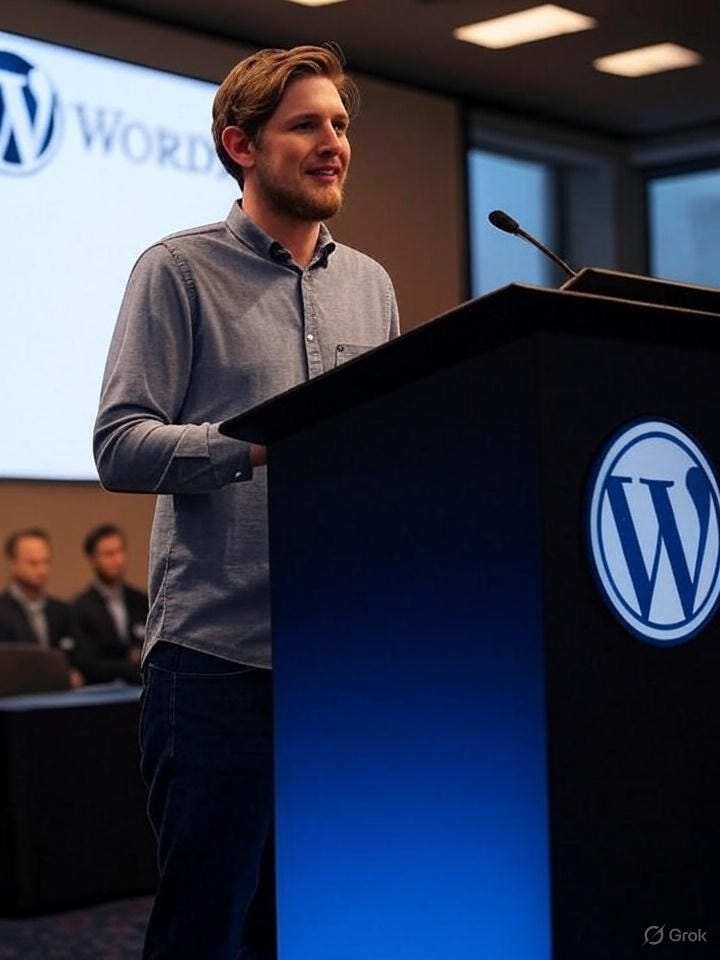From 20 Views to $100K: WordPress, Open Source, and My Blogging Journey
The 20-View Ego Check
My first Substack post garnered a measly 20 views, and I won’t lie – that stung my pride. After decades of blogging, seeing such a low number felt like a comedian telling a joke to an empty room. I refreshed the stats page a few times (you know, just in case 20 was a caching error). Nope. Twenty humans – probably including my mom – read it.
In internet terms, that’s basically crickets.
It was a humbling reminder that no matter your past success, every new platform makes you start from scratch. As WordPress co-founder Matt Mullenweg famously said:
“Usage is like oxygen for ideas. You can never fully anticipate how an audience is going to react to something you've created until it's out there.”
In other words, you’ve got to put your work into the wild and be ready for anything – even indifference. My ego was bruised, sure, but this ego-check also got me reminiscing. It’s been ~25 years since I first dove into blogging, and boy, have things changed.
Launching My Blog on Early WordPress (Thank You, Open Source!)
In the early 2000s, I was just an eager blogger with a dream (and a dial-up modem). Around 2003, I launched my blog Garmahis.com on the initial version of WordPress – back when WordPress was the scrappy new kid that Matt Mullenweg and Mike Little had just released to the world. Huge kudos to Matt for that leap of faith in open source!
WordPress in those days was super minimal. No one-click installs, no fancy page builders – just a basic editor, a handful of themes, and a whole lot of potential. I vividly remember tinkering with PHP snippets and CSS to customize my site, feeling like a hacker extraordinaire when I changed a font or moved a sidebar.
Even in its infancy, WordPress had a vibe: “a state-of-the-art semantic personal publishing platform,” as the homepage proudly proclaimed. Translation: a blogger’s best friend.
Fast forward to today, and WordPress has done some serious growing up. What started as a 19-year-old’s side project grew into the world’s most popular content management system (CMS). It’s used by major publishers like CNN, TechCrunch, and even Beyoncé. The beauty? Whether you were a solo blogger or a media giant, you had access to the same publishing power.
The Open Source Advantage: Power, Freedom, and Community
From day one, one of the most important factors in my blog’s success was that WordPress is open source. What does that mean in practice? It meant freedom. I wasn’t locked into a proprietary platform’s choices or fees. I could host my site anywhere, tweak the code, install plugins, and truly own my content.
Highlights:
Community Contributions: Need a contact form or SEO plugin? Someone already built it—and gave it away.
Cost Efficiency: WordPress itself was free. I bootstrapped with shared hosting and grit.
Control & Ownership: No algorithmic overlords. Just me and my readers.
Philosophy: The mission to democratize publishing wasn’t just PR—it was real.
As Matt once said:
“I believe that open source is the most important idea of our generation.”
And he walked the walk.
Growing from Zero to Hundreds of Thousands (and a $100K Exit)
When I hit “Publish” on my first WordPress post all those years ago, I had exactly 0 readers. But I stayed consistent. I wrote about web design, digital tools, productivity—anything that could help people create online. I learned SEO by trial and error. I joined forums, commented on other blogs, and over time, a trickle became a wave.
Eventually, the blog was getting hundreds of thousands of visits. It became a small business. I monetized through affiliate programs, digital products, and a few well-placed ads. I didn’t need venture capital. I didn’t need an MBA. I just needed WordPress, content people cared about, and a willingness to hustle.
Then came the moment I didn’t expect: a buyer on Flippa offered $100,000 for my blog.
I still remember double-checking the listing to make sure it wasn’t Zimbabwean dollars. Nope—it was USD. I had taken a humble little open source blog and turned it into a six-figure asset.
How I Spent the $100K (or, The Apple That Got Away 🍏)
What did I do with that $100K? Did I invest it wisely in a diversified portfolio of ETFs and emerging tech stocks?
Of course not.
I did what any self-respecting nerd-blogger does when they hit a windfall: I blew a chunk of it on Apple gear.
I’m talking MacBook Airs, iPhones, iPads—basically trying to singlehandedly boost Cupertino’s Q4 revenue. If it had a glowing logo, it was in my backpack.
Did I consider buying Apple stock instead? Very briefly. Then I looked at my shiny new devices and thought, “This is basically the same thing, right?”
Spoiler: it was not. (AAPL has since tripled. My iPad battery? Not so much.)
And because YOLO was basically my investment strategy, I took what was left and spent a year living it up in Torremolinos, a sunny gem on the southern coast of Spain. Beach cafés, tapas, siestas, blazing fast Wi-Fi, and no alarm clocks. It was glorious.
I worked on a few side projects, blogged a bit, and watched Mediterranean sunsets like a retired Instagram poet. Would Apple stock have been the “smarter” choice? Probably. But the freedom and life experience I gained? Priceless. Plus, who else can say a blog took them from PHP to paella?
Blogging Then vs Now: Why the Open Web Still Matters
So here I am in 2025, starting fresh on Substack with just 20 views to my name. Back in the day, it felt like the blogosphere was the heartbeat of the internet. RSS feeds, blogrolls, link exchanges—it was a scene. You could grow organically and actually own your relationship with readers.
Today, platforms like Substack offer an easier on-ramp. No setup headaches, no plugin mishaps. But you're also playing in someone else's sandbox. It’s convenient, but it comes at a cost—less control, less ownership.
As Matt put it:
“If you spend a million dollars on open source, you probably have something amazing that other people can build on.”
Substack may be slick, but it doesn’t quite give me that same tinkerer's freedom. And the web needs both—plug-and-play options and the open, hackable, own-your-platform stuff that made blogging what it is.
Conclusion: From Open Source to Open Sangria
The journey from 0 to hundreds of thousands of readers, from WordPress newbie to blog-flipping ex-pat, has been anything but linear. It’s involved late nights, plugin crashes, SEO rabbit holes, ego boosts, ego bruises, and enough markdown syntax to make my brain twitch.
But it was worth it.
Thanks to WordPress and open source, I turned my thoughts into a six-figure exit and a year of Mediterranean living. And while Substack is a new kind of mountain to climb, I’m not afraid of the uphill.
After all, I’ve started from zero before. With fewer tools. With less experience. With dial-up.
So bring on the 20 views. The 21st might be the next chapter of something big.



